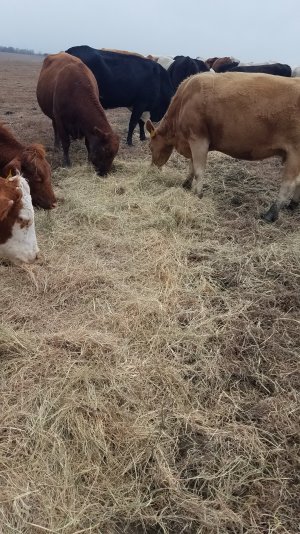If you look back in this thread to 2020, you'll see that I advocated for bale grazing... and I certainly do think that there's a place for it. But it's all about "context" of what you need to accomplish in the environment you've been dealt. I'm running considerably more animals now than I was in 2020 (perhaps 100 head then, vs. nearly 400 head now). And contrary to what one might expect because of labor requirements, I now PREFER to unroll my hay, vs. bale grazing.
Remember where I'm at... Minnesota..., where we have "poor man's concrete" for months upon months working in our favor. And we have SNOW... enough that you simply can't get around at all, even empty, with a regular 4 wheeler or SXS or pickup. A snowmobile could work for transportaion of a man..., but a tractor with chains... and/or FWA is the only practical means of getting around with any amount of weight (a bale for example), period. And even that will be sketchy at times, but for the most part, you ARE able to get around reasonably well. If/when it gets too deep, bale grazing is potentially the only REAL option... so you might wish you had SOME bales set out ahead of time, just so you could feed those cows "somehow". That's your "insurance".
One thing that many don't realize is that snow eventually can/will render your electric fences almost worthless... The cattle don't "ground" very well through a snow pack (even with a super big, appropriately grounded fencer). Deep snow can bury fences completely, and drag down the wires, potentially forcing them onto the ground itself... reducing its potential effectiveness and strength of shock. When you have hundreds of feet of fence buried or pulled down onto the ground, the shocking ability is quickly minimized if not eliminated. And there's no cure for that, other than springtime. You're not going to go out there and "unbury" hundreds or perhaps thousands of feet of drifted in fenceline.
With bale grazing and relatively few animals, your "headaches" are pretty minimal. But you're also "locked in" to your plan, with no ability to adapt to unforseen issues that might arise. If unrolling as required, you CAN regulate how much they're receiving more easily, when they'll receive it, and WHERE it might be placed. If the weather is going to be bad with wind, I CAN feed where the animals have more protection. On "nice" days, I can feed them where they're more exposed. If the fence in a particular area is going to get buried by snow later in the winter, I CAN feed in that area prior to getting the snow, so that they're not tempted by that buried fence later. If it's going to be muddy, I CAN feed on high ground on those days... I CAN feed at night when it might be frozen, etc. I CAN spread those animals out over a MUCH larger area if necessary. You maintain far more adaptability. I CAN manage on a daily basis to minimize hay wastage much better than with bale grazing. But those "adaptive advantages" comes with a cost... it means you (labor) have to be starting a tractor (equipment/fuel) regularly throughout the winter to feed them.
When I unroll my bales, I currently end up with a windrow over a half mile long, with cattle spread out over that full length. When I get to the far end of the windrow unrolling, I turn around and come back... all along the length of that windrow, eyeballing every single animal individually, to see how they're doing, and to find any "problems" that might need attention. With a big herd, that's a huge benefit... not so much with like 20 head or so. And you can avoid too heavily concentrated hoof impacts, and over-applied residues and manure nutrients.


